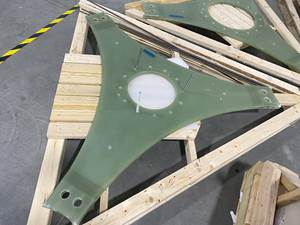GWEC reports 51.3 GW of new wind capacity in 2018
The Global Wind Energy Council’s latest data shows that China led both offshore and onshore wind energy installation in 2018.
The Global Wind Energy Council (GWEC, Brussels, Belgium) reported in late February that the global wind energy industry installed 51.3 gigawatts of new capacity in 2018. Since 2014, the global wind market’s growth has been stable, installing more than 50 gigawatts of new capacity each year.
Despite a 3.9 percent decrease in the global onshore market in annual terms, there was promise shown by growth in developing regions such as Latin America, Southeast Asia and Africa, which were responsible for 10 percent of new onshore installations in 2018, totaling 4.8 gigawatts.
The global offshore market grew by 0.5 percent in 2018, with new installations of 4.49 gigawatts, reaching a total installed capacity of 23 gigawatts. For the first time, China installed more offshore capacity than any other market (1.8 gigawatts), followed by the United Kingdom (1.3 gigawatts) and Germany (0.9 gigawatts). GWEC forecasts that offshore wind will become an increasingly global market. If governments remain committed, and projects and investments continue, annual installations in Asia could reach 5 gigawatts or more each year, according to GWEC. In the U.S., GWEC expects the developing offshore wind market to reach 1 gigawatt by 2022 or 2023.
GWEC forecasts that new installations will reach 55 gigawatts or more each year until 2023. Stable volume is predicted to come from mature regions in Europe and the U.S., while significant growth is forecast to be driven by developing markets in Southeast Asia and the global offshore market.
According to GWEC’s report, total installed wind capacity reached 591 gigawatts at the end of 2018, a growth of 9.6 percent compared to the end of 2017. Total installed onshore wind grew by 9 percent, while total offshore wind grew by 20 percent, reaching 23 gigawatts.
“2018 was a positive year for wind in all major markets, with China leading both onshore and offshore growth,” says Ben Backwell, CEO of GWEC. “We expect huge growth in Asia through the coming decade and beyond as part of the continuing shift from Europe to Asia as the driving region for wind development. However, government support and policy are key to enabling faster market growth in key regions such as Southeast Asia.”
“Since 2014, the global wind industry has added more than 50 gigawatts of new capacity each year, and we expect 55 gigawatts or more to be added each year until 2023,” says Karin Ohlenforst, director of market intelligence at GWEC “In particular, the offshore market will grow on a global scale and will reach up to 7-8 gigawatts of new capacity during 2022 and 2023.”
These latest figures released by GWEC form the statistical release of the Global Wind Report, GWEC’s flagship publication. The full report will be released on April 3, 2019. GWEC will host a webinar about the report’s findings on April 3.
According to GWEC’s findings, the top 10 onshore markets in 2018:
- China – 21,200 MW
- USA – 7,588 MW
- Germany – 2,402 MW
- India – 2,191 MW
- Brazil – 1,939 MW
- France – 1,563 MW
- Mexico – 929 MW
- Sweden – 717 MW
- United Kingdom – 589 MW
- Canada – 566 MW
Top offshore markets in 2018:
- China – 1,800 MW
- United Kingdom – 1,312 MW
- Germany – 969 MW
- Belgium – 309 MW
- Denmark – 61 MW
Related Content
Polar Technology develops innovative solutions for hydrogen storage
Conformable “Hydrogen in a Box” prototype for compressed gas storage has been tested to 350 and 700 bar, liquid hydrogen storage is being evaluated.
Read MoreMingYang reveals 18-MW offshore wind turbine model with 140-meter-long blades
The Chinese wind turbine manufacturer surpasses its 16-MW platform, optimizes wind farm construction costs for 1-GW wind farms.
Read MoreRTM, dry braided fabric enable faster, cost-effective manufacture for hydrokinetic turbine components
Switching from prepreg to RTM led to significant time and cost savings for the manufacture of fiberglass struts and complex carbon fiber composite foils that power ORPC’s RivGen systems.
Read MoreInfinite Composites: Type V tanks for space, hydrogen, automotive and more
After a decade of proving its linerless, weight-saving composite tanks with NASA and more than 30 aerospace companies, this CryoSphere pioneer is scaling for growth in commercial space and sustainable transportation on Earth.
Read MoreRead Next
“Structured air” TPS safeguards composite structures
Powered by an 85% air/15% pure polyimide aerogel, Blueshift’s novel material system protects structures during transient thermal events from -200°C to beyond 2400°C for rockets, battery boxes and more.
Read MoreAll-recycled, needle-punched nonwoven CFRP slashes carbon footprint of Formula 2 seat
Dallara and Tenowo collaborate to produce a race-ready Formula 2 seat using recycled carbon fiber, reducing CO2 emissions by 97.5% compared to virgin materials.
Read MoreVIDEO: High-volume processing for fiberglass components
Cannon Ergos, a company specializing in high-ton presses and equipment for composites fabrication and plastics processing, displayed automotive and industrial components at CAMX 2024.
Read More
.jpg;width=70;height=70;mode=crop)












.jpg;maxWidth=300;quality=90)











